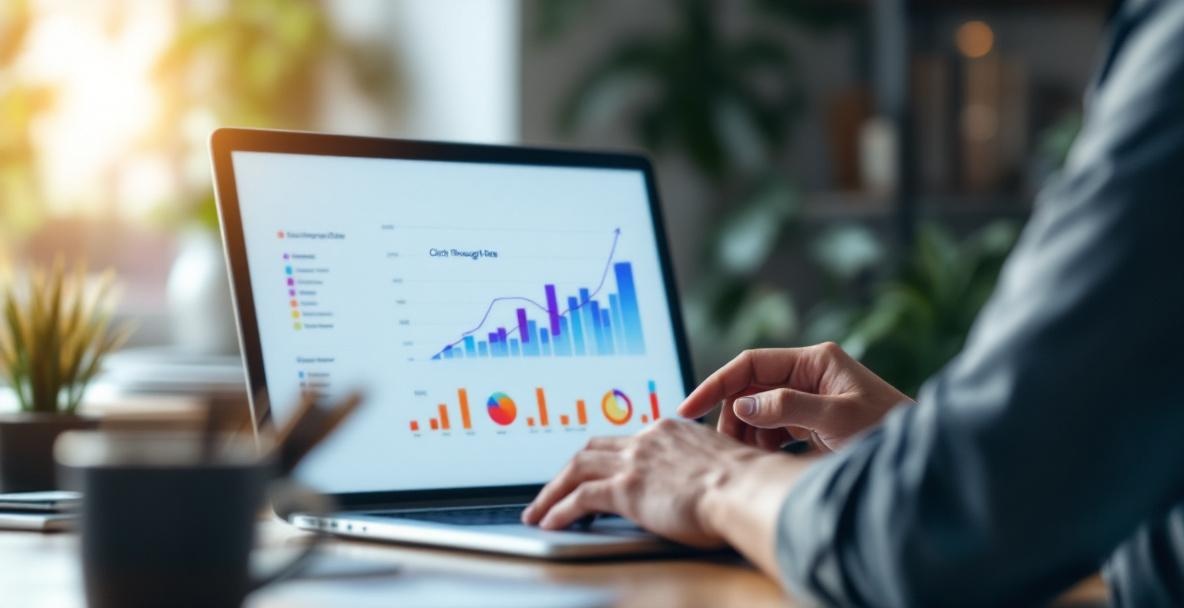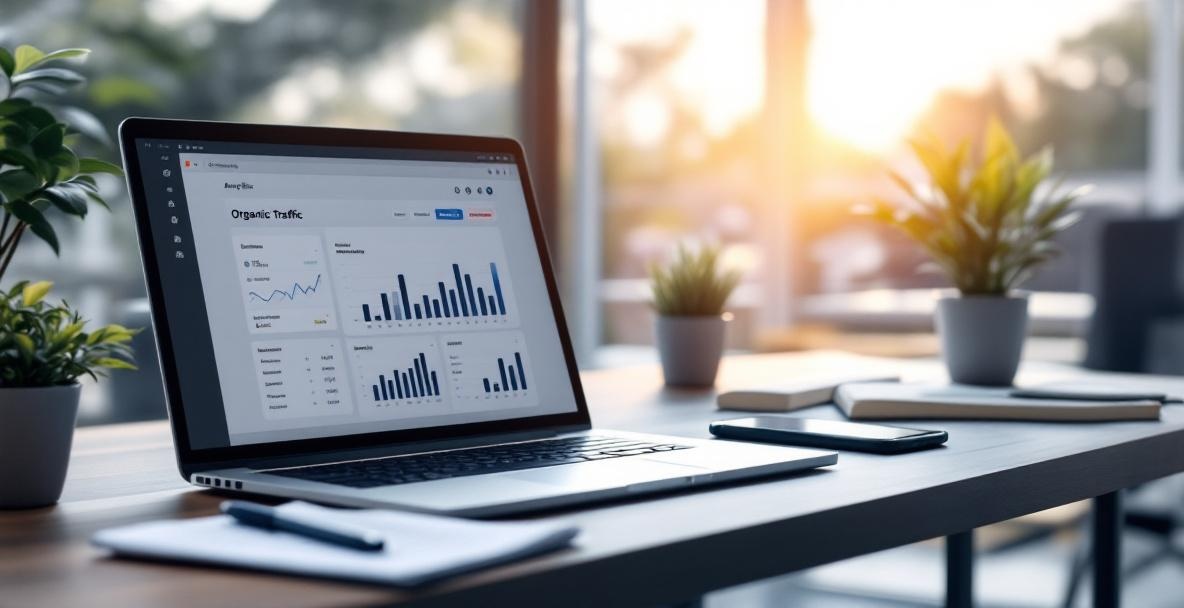Why Click-Through Rate Matters for Your Business

Ever noticed a webpage that makes you immediately want to click? At SeoFlow, we believe your click-through rate (CTR) is the secret behind that instant appeal. Whether you run ads, fine-tune your search listings, or send out email campaigns, a strong CTR brings more than just extra clicks-it builds trust and drives long-term success. This small metric can turn a quiet online presence into one that grows steadily and converts visitors into loyal customers.
“Your CTR influences not just immediate traffic but also long-term algorithm favor, conversion potential, and ultimately, your bottom line.”
So, What Exactly is CTR?
CTR is simply the percentage of people who click your link after they see it in search results, ads, or emails. You calculate it by dividing the number of clicks by the number of views and then multiplying by 100. For example, if your search listing gets 100 views and 5 clicks, your CTR is 5%. This tells you whether your title tags, meta descriptions, or ad copy are doing a good job of drawing interest.
Different industries experience different CTR levels. For instance, online stores usually see about 1.66% on ads, while finance and insurance might hit around 2.65%. In organic search, the very top spot can pull in between 20-30%, and email campaigns generally get 2-5% (with B2B on the lower end and B2C on the higher end). At SeoFlow, we know that optimizing content for search intent can really give these numbers a boost.
Below is a snapshot comparing average CTR ranges across channels and industries:
| Channel | Industry | Average CTR (Low) | Average CTR (High) |
|---|---|---|---|
| Paid Search Ads | E-commerce | 1.0% | 1.8% |
| Paid Search Ads | Finance & Insurance | 2.0% | 2.8% |
| Organic Search (Position 1) | Cross-industry | 20% | 30% |
| Organic Search (Positions 2-3) | Cross-industry | 10% | 15% |
| Email Marketing | B2B | 2% | 4% |
| Email Marketing | B2C | 3% | 5% |
Compare your numbers against these benchmarks to see where you can improve.
Knowing your industry’s figures gives you clear targets, but you should always look to do even better. CTR isn’t just a vanity metric-it shows how well your message connects with your audience at that crucial moment when they decide whether to click or scroll past.
How a Low CTR Can Hurt Your Business
When your CTR stays low, it can hurt your marketing in several ways. For pay-per-click campaigns, low click rates mean you end up paying more for each click because platforms like Google Ads charge extra for ads that don’t perform well. Simply put, you lose money reaching fewer people.
In organic search, if users routinely skip your listing, search engines begin to see your content as less relevant. Over time, this can drop your rankings, which makes it even harder to get noticed. In email campaigns, a low CTR not only wastes your effort but can also hurt your sender reputation if messages land in spam folders. Every missed click is a chance lost to connect with a potential customer.
“Low CTRs directly increase your cost per click as platforms like Google Ads penalize underperforming ads with higher prices and lower placement.”
When your ads and emails perform poorly, the impact ripples across your entire strategy. Take a look at this summary:
| Area | Low CTR Impact | Improved CTR Benefit |
|---|---|---|
| PPC Cost-per-Click | ↑ 20-50% costs from lower Quality Score | ↓ up to 30% costs through Quality Score gains |
| Organic Rankings | Gradual position loss due to poor engagement | Sustained or higher positions from positive signals |
| Email Deliverability | Increased spam/promotions filtering | Better inbox placement & higher opens |
| Conversion Rate | Fewer qualified visitors and sales | Larger, more engaged audience boosts conversions |
Creating Headlines and Descriptions That Get Noticed

When it comes to beating the competition, your headline and description are like a friendly sign that invites clicks. No matter how good your underlying content is, a weak title can leave it unnoticed. At SeoFlow, we know that your titles and descriptions are the first chance to make a great impression, urging visitors to explore further.
Tips for Writing a Headline That Hooks You
“A powerful headline does more than simply describe your content-it creates an irresistible invitation to click.”
A great headline should do more than state the topic. It is an invitation that hooks you instantly. Start with clear language and add a touch of emotion or urgency. Headlines that clearly speak to what a searcher is looking for work much better than vague titles.
Using power words can change a headline from ordinary to outstanding. Words like essential, proven, exclusive, or ultimate signal that the content is valuable and worth your time. Just use them sparingly so your headline stays genuine. One or two well-chosen words are usually enough to make your headline pop.
Speak directly to what your readers need. Instead of a bland title like "SEO Tips for Websites," try "5 SEO Strategies That Will Double Your Organic Traffic." This way, your title tells exactly what readers will get, which grabs attention and encourages clicks.
How to Write a Meta Description That Sells
While the headline draws you in, the meta description convinces you to stay. A good description expands on the headline's promise and offers just enough extra detail to spark interest-all within 155-160 characters. Think of it as a quick pitch that shows what the page has to offer.
A strong meta description presents a clear benefit and a subtle call to action so readers see exactly what they can gain. For example, "Learn how our proven SEO techniques have helped businesses increase organic traffic by 43% on average. Discover actionable strategies you can implement today." This tells readers the value they’ll receive and makes them eager to click.
Keep your headline and description aligned. When they match well, readers feel confident in what they will get. Descriptions that tie neatly with search intent not only improve your CTR but also help keep visitors engaged once they arrive.
Using Images and Multimedia to Boost Clicks

Strong visuals can be the difference between a skipped listing and a click. A well-chosen image or video can capture attention when people scan search results. When your multimedia is eye-catching and true to your message, it can give you an edge over the competition. Let’s look at how to use images and multimedia to improve your CTR and keep visitors engaged.
Picking Visuals That Tell Your Story
Choosing the right visuals isn’t just about finding an attractive picture-it’s about matching your style with your audience’s expectations. For business-to-business content, crisp and professional graphics work best. On the other hand, if you’re reaching out to consumers, images that evoke emotion or show a lifestyle may work better.
| Visual Element | Typical Engagement Lift | Best Use Case | File Size Considerations |
|---|---|---|---|
| Custom Static Image | +30% views vs text-only | Blog hero banners, product highlights | Compress to <100 KB |
| Infographic | +50% shares on social | Data-rich tutorials, reports | Use vector formats for scalability |
| Short Explainer Video (<60 s) | +70% average time on page | Demonstrations, FAQs | H.264 MP4 under 10 MB |
| Interactive Poll/Quiz | +25% CTR from SERP snippets | Lead magnets, assessments | Load asynchronously |
Getting the right mix of multimedia boosts both engagement and your rankings. Quality matters, so choose high-resolution images that load quickly and display well on any device. Steer clear of generic stock photos-invest in custom graphics, authentic team shots, or premium images that truly match your message and help your content stand out.
Pay attention to the technical details too. Make sure your image files are named properly and include descriptive alt text. This not only makes your site more accessible but also helps improve your SEO. When visuals support your text rather than distract from it, your message comes through loud and clear.
How Multimedia Can Boost Your Message
Multimedia is not just decoration-it plays a key role in telling your story. Map out the journey of your content and pinpoint where images, charts, or brief videos can clear things up or add an emotional touch. For example, an infographic can turn complex data into an easy-to-digest visual, and a short clip can explain a process in a way that words simply cannot.
Make your visuals flow naturally. Start with a striking image to draw attention, then add details as your reader scrolls. This sequential storytelling keeps people engaged and can even extend the time they spend on your page. When each visual ties in seamlessly with your message, your audience is more likely to absorb the information and come back for more.
Mixing different types of visuals can also cater to different preferences. Try pairing static images with a few interactive elements like simple polls or small animations. Studies show that clear, human-centered visuals increase engagement, so every picture or video should add something meaningful to your message.
Making Sure Your Site Shines on Mobile

Mobile matters. More than half of web visitors use smartphones, so a mobile-friendly site is a must. At SeoFlow, we see that pages built for mobile not only get more clicks but also drive higher conversions. A smooth experience on mobile can turn a quick glance into a lasting connection with your site.
Responsive Design and Super-Fast Loading
A responsive design is essential for any mobile site. When your website adjusts to fit various screens, visitors get a consistent experience no matter what device they use. This not only makes things easier for your audience but also helps boost your search rankings and CTR.
Loading speed is equally important. Mobile users may face slower connections, so compress images, use browser caching, and trim down your code to keep load times under three seconds. Faster pages lead to lower bounce rates, and studies show that quick-loading sites keep visitors clicking and exploring.
You might also consider using AMP (Accelerated Mobile Pages) for content-heavy sections. AMP can make your blog posts or news articles load much faster, ensuring a smoother, more engaging mobile experience that helps improve your overall CTR.
Engaging Interactive Features on Mobile
Mobile visitors appreciate interactive features made for touch screens. Simple polls, quizzes, or swipeable galleries can make your page more engaging and keep visitors exploring longer. Research indicates that when these features are designed with the user in mind, they can boost your CTR by up to 25%. Ensure these elements are sized just right for thumb taps.
Short, interactive assessments that deliver immediate value perform especially well. For example, a prompt like "Take our 30-second quiz to find your ideal content strategy" gives a clear call to action, prompting more clicks. Keep these features light so they don’t slow your page down.
Interactive elements go beyond quizzes and polls; think about tap-to-expand sections, interactive infographics, or useful calculators. Even email campaigns tailored for mobile can see a jump in CTR when optimized properly. Each interactive piece should have a clear purpose-whether it’s to educate, personalize, or solve a problem for your audience.
Bringing It All Together
We have shared plenty of tips to help boost your CTR and improve your online presence. These techniques are not just quick fixes; they are part of a lasting approach that can grow your traffic and keep your audience engaged. Up next is a quick review of the best ideas and some clear steps you can take to see real results.
Quick Recap of the Top Tips
We started with the importance of writing headlines and meta descriptions that speak directly to your audience. These small details form the first impression and play a big role in whether a visitor clicks through to your site. We focused on using emotional triggers, sparking curiosity, and clearly stating benefits to catch attention.
Then we talked about boosting engagement with the right images and videos. Multimedia elements not only break up long text but also make your message more relatable. When visuals are optimized with clear filenames and alt text, they improve both user experience and your search rankings.
We also stressed the need for mobile optimization. With so much traffic coming from smartphones, a fast-loading, responsive site that is easy to navigate is crucial for capturing clicks and keeping visitors on your page.
What You Should Do Next
Start by reviewing your current content. Take a close look at your title tags and meta descriptions, and check your CTR data in Google Search Console against industry benchmarks. Pick a few pages that aren’t performing as well and update them with clearer, more engaging headlines and descriptions. This focused effort will help you see results before scaling up changes across your entire site.
Next, set up a plan for enhancing your visuals. Review your most-visited pages and add high-quality images or videos that truly support your message. Ensure these files are compressed and tagged correctly so they load quickly. Also, consider using advanced content creation tools to speed up your visual improvements.
Finally, keep mobile optimization at the top of your list. Run Google’s Mobile-Friendly Test to uncover any issues and fix them one by one. When your site meets users’ needs quickly and clearly on mobile, you boost your CTR and make it easier for visitors to find the information they seek.
Ready to Boost Your CTR?
It’s time to turn these ideas into real gains for your CTR. Pick one tip from this guide and try it this week. Note your current numbers, then check back after 30 days to see the progress. Small, steady improvements can lead to big growth over time.
Share your wins and challenges with fellow marketers in forums or on social media. The insights you exchange may spark even more great ideas. Remember, boosting your CTR is a continuous journey of testing, learning, and refining your approach.
Ready to automate your CTR improvement strategy and save countless hours in the process? At SeoFlow, we've built a platform that handles the entire content optimization lifecycle – from spotting underperforming pages to applying proven CTR boosting techniques. Our advanced system helps you roll these strategies out across your site while keeping your unique brand voice intact.



